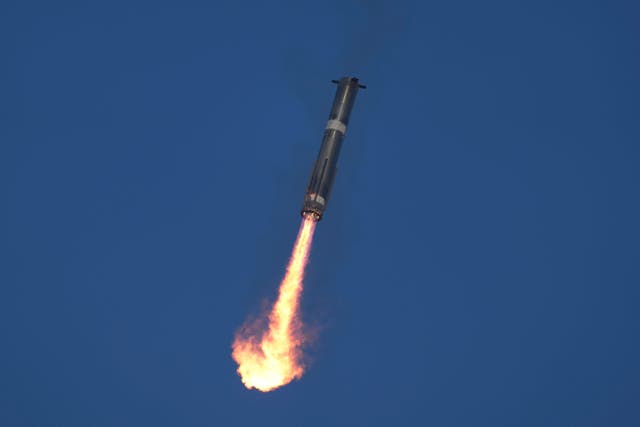SpaceX launched its Starship rocket on its latest test flight, but the spacecraft was destroyed following a thrilling booster catch back at the pad.
Elon Musk’s company said on Thursday the spacecraft’s six engines appeared to shut down one by one, with contact lost just eight-and-a-half minutes into the flight.
The spacecraft was supposed to soar across the Gulf of Mexico from Texas on a near loop around the world similar to previous test flights.

A minute earlier, SpaceX used the launch tower’s giant mechanical arms to catch the returning booster, a feat achieved only once before.
The descending booster hovered over the launch pad before being gripped by the pair of arms dubbed chopsticks.
The thrill of the catch quickly turned into disappointment for not only the company, but the crowds gathered along the southern tip of Texas.
“It was great to see a booster come down, but we are obviously bummed out about the ship,” said SpaceX spokesman Dan Huot, adding it would take time to analyse the data and figure out what happened.
“It’s a flight test. It’s an experimental vehicle.”
The last data received from the spacecraft indicated an altitude of 90 miles and a velocity of 13,245mph.
The 400-foot rocket had thundered away in the late afternoon from Boca Chica Beach near the Mexican border. The late hour ensured a daylight entry halfway around the world in the Indian Ocean.
But the shiny retro-looking spacecraft never got nearly that far.
Starship experienced a rapid unscheduled disassembly during its ascent burn. Teams will continue to review data from today’s flight test to better understand root cause.
With a test like this, success comes from what we learn, and today’s flight will help us improve Starship’s…
— SpaceX (@SpaceX) January 16, 2025
SpaceX had upgraded the spacecraft for the latest demo. The test satellites were the same size as SpaceX’s Starlink internet satellites and, like the spacecraft, were meant to be destroyed upon entry.
Mr Musk plans to launch actual Starlinks on Starships before moving on to other satellites and, eventually, crews.
It was the seventh test flight for the world’s biggest and most powerful rocket. Nasa has reserved a pair of Starships to land astronauts on the moon later this decade.
Mr Musk’s goal is Mars.
Hours earlier in Florida, another billionaire’s rocket company — Jeff Bezos’ Blue Origin — launched the newest supersized rocket, New Glenn.
The rocket reached orbit on its first flight, placing an experimental satellite thousands of miles above Earth. But the first-stage booster was destroyed, missing its targeted landing on a floating platform in the Atlantic.






